Display and contextual advertising. All About Online Display Advertising
Display advertising is a tool for marketing promotion of brands, sites, trademarks, goods, services, etc., when product information is placed on the platforms of the media (mass media).
The main difference between display advertising and other types of advertising is the key factor - consumer attention is drawn through the visualization of information (flash pictures, videos, images, etc.).
Thanks to the visual delivery of information, such an advertisement is more quickly perceived by the consumer, one does not need to delve into its meaning, and no time is spent reading it. Most often, display advertising reaches the consciousness of consumers, even if they do not plan to be interested in it (the eye slipped through the banner between the transitions to Internet pages, but the information was remembered subconsciously).
It is precisely this effect that advertisers are counting on when they are developing yet another advertising campaign for the media.
The benefits of media advertising
Using banner advertising, you can solve the following tasks:
1) Increase traffic to the advertised site.
2) Increase sales of the promoted product, especially when it comes to any exclusive, expensive, innovative products. In this case, display advertising is the best way to talk about a new product to a user who does not yet know about its existence and, accordingly, is not interested in it.
3) To inform the target audience about profitable offers, current promotions and discounts.
4) Notify a wide audience of new large-scale events (films, exhibitions, concerts and other events). In this case, display advertising replaces posters.
Information spaces for media advertising
Depending on the type of platform on which the display will be placed, the following media are distinguished: 1) Television, which broadcasts promotional videos at a specific time.
2) Printed publications that place ad units on their pages.
3) Internet media (sites, electronic magazines, electronic newspapers, news and information resources, popular social networks) that have the technical ability and desire to place a banner ad unit on their pages.
Banner advertising comes in the following formats:
- graphic banners (static blocks).
- flash-banners (dynamic pictures, videos).
- TopLine ("extensions" located above the main content of the page or at the bottom).
- Rich-Media (banner blocks on top of the content of the site that will obsessively “run” after the mouse until they are closed).
- Pop-Under (ads that open in a new browser window if users click on the information they need), etc.
Feature of banner advertising
1) Banner advertising adopted the properties of contextual advertising, due to which it is shown to users depending on their search queries and the geography of their location.
2) Banner advertising is the most annoying form of display advertising. An Internet user is often disturbed when something “flickers” before his eyes (flash-banner), closes half of the space of the desired page (Rich-Media) or ad units “jump by themselves”, so you need to spend time to close them.
90% of users are intolerant of such distracting ads. The most loyal visitors to sites are graphic blocks at the top or bottom of the site (TopLine).
Each advertiser decides on their own - which is more priority for him, to be sure to remember even with negative associations or to get a loyal customer, because users who are looking for purposefully are more attentive.
References
This is a compilation of an encyclopedic article on this topic. You can contribute to the development of the project by improving and supplementing the publication text in accordance with the project rules. User manual you can find
At one time, we argued for a long time in which category transport advertising was. In theory, this is an outdoor advertisement designed to attract the attention of users, which means it refers to display advertising. The same goes for online advertising; it is also included in display advertising. Therefore, let’s look at what is display advertising in this article, what it consists of and what can be useful for business.
Meal'n'Real
Display ad - A special type of advertising that is focused on a spectacular audience perception. Its main task is to attract the attention of a person. For this, various technologies are used that contain texts, pictures, infographics, company logos, maps and more.
Let's do a little experiment. Remember the ad you saw today. Most likely, you can’t even remember the last 5 advertising messages. This is normal. Too much noise. And in 95% of cases this noise is generated by display advertising, because the following channels are included here:
- Advertising on TV;
- Advertising on the radio;
- Advertising in the press (in print);
- Internet advertising;
- Outdoor advertising;
- Internal advertising. A kind of under POS advertising. That is, a cross between outdoor advertising and selling price tags in the store itself. To give an example, this is an advertisement inside shopping centers leading to a shopping pavilion;
- Advertising on transport.
From what we saw above, we can conclude that all advertising is related to media. But this is not so. From the list you can safely cross off all advertising “head-on”, which can also be called “no picture”, namely:
- Cold calls or cold “calls” (telemarketing);
- Advertising catalogs and brochures;
- Souvenir products;
- Promo events.
In short, a display advertising is any advertising containing a picture and text, the main task of which is not direct sale, but first of all drawing the consumer's attention to it. And I’ll probably say something stupid now, but it suits everyone. Without exception. For example:
- Niche b2b - ideal for advertising in the press, as well as transit advertising (branded transport that delivers orders to customers);
- The niche of b2c is advertising on TV or radio, although many refuse it because of its high cost in favor of outdoor and indoor advertising.
Or a universal “gentleman's set” for all areas - + customized. The same advertisement on the Internet. But there may be other options. For example, one of our clients was able to achieve much more by pasting up ads in the entrances, as well as by placing regular ads in newspapers than using other various ones.
WE HAVE ALREADY MORE THAN 45,000 people.
TURN ON
The only thing is that the effectiveness of such advertising does not justify investments in all areas. But you follow our youtube channel, right ?! So one of the last videos, “Bad advertising does not exist,” has not passed by you. No?! Then there it is. A must-see for learning Zen.
The death of offline display advertising
Our satellite TV client decided to declare war on his competitors. In the literal sense of the word. The advertising company began on the Internet and the budget for the year was determined in the amount of 2-3 million rubles. Provided that for the most part it was, and not made by technology or.
Competitors “died in batches." And at that moment, when the number of competitors decreased to the number of fingers of one hand and the advertising budget was almost exhausted, and potential buyers were simply “sickened”, the season came and the client decided to allot a small budget for offline advertising, which is called “for trial” .
What was his amazement when the results from the “advertising on trial” turned out to be more significant, and the advertisement itself was more effective. It was after this moment that I again believed in traditional advertising and that it works, at least in the regions. But this is a small digression.
The pain of the difference: offline and online
The main difference between online and offline display ads is the audience this ad is shown. That is, on the Internet this can be done more targeted, that is, to show your ads more accurately (choose a specific geography of the show, the age of people, etc., or only on thematic sites).
Offline, there is no such function. This is precisely what gives rise to the second difference. Aggressiveness. Offline, in order to skip a commercial that we are not interested in, you have to switch to another channel. On the Internet, I can close my uninteresting banner or website. And calmly move on.
And the main disadvantage of this type of advertising (offline media advertising) is its high cost and effectiveness / inefficiency. About advertising on TV, I think you are already in the know. There the cost of accommodation (especially if it is a federal channel) is just off scale.
One of our clients, successfully working for more than 20 years in the services market and having 6 branches in Moscow and the Moscow Region, with a monthly budget for website promotion of about 200 thousand rubles, cannot afford to advertise on the federal channel for two reasons: the huge cost of placement and incomprehensible effect in contrast to the same contextual advertising.
Display Media
In our blog we wrote a huge number of articles on various channels and advertising methods. To study them, first read these 3 articles:
After studying these articles, you will decide on specific ways of presenting information, which can conditionally be divided into four means of transmission (type). Which is more effective and how to apply them to your business, we will consider further on the example of several companies.
Banners
Those same advertising banners, which are swarming with all the streets and open spaces of the Internet. Dimensions and placements are measured in hundreds of variations. As a rule, the larger the size, the more attracted attention. The more passable the place, the more expensive the cost.
Offline we still pay for the fact of placement. On the Internet, the method has evolved and become more customer-oriented, that is, payment for clicks has appeared. But city and small sites also have a placement scheme with payment for the time that it will be on the site or for the number of impressions on the site.
It’s now fashionable to call such media banners “teasers” (“teaser” - teasing). That is, they tease the user with their information to perform the target action: log in, call, click or go to the site.
Banner display advertising (whether it is offline or online, regardless) has one serious minus - the high price. In offline space, on average, you will give between 10 and 50 tr for one banner. Within the framework of online space, I will give an example of placing a banner for a week on the Yandex main page.
You see everything right. Figures start at 4 million per week. You can find the full price list on their website. But this is if you have a federal project and you need to cover more than all.
However, I want to warn you. Banners became boring to such an extent that now there is the so-called banner blindness. This is when the client does not psychologically notice the banner ads. Therefore, just in case, think well and count it all over again, if you suddenly decide to put the entire advertising budget for the purchase of one banner.
Video ad
The most engaging media tool. True, it takes time to assimilate. Due to ignorance of this, we once lost a large amount of money. Namely, they gave video ads to directors on social networks during working hours. Result?! They opened it, but did not turn on the sound, as they were at work.
Besides the fact that it is important to know at what time to show ads globally, you need to know what to show and how long. I’m sure you’ll figure out when and what to show, but I’ll tell you a long one, because there are 2 types of video ads:

Personally, we are now focusing heavily on video ads. Although it takes up more resources, the effectiveness of display advertising in this form gives the maximum effect. But do not forget about our mistake. In addition to video, you also need to use text with an image, because not everyone has time to watch the video and not everyone likes to do it.
Branded advertising
You can read the headline as branded, but actually branded. This is a display advertising that is available only to large companies. Its main goal is brand recognition or the so-called. It is also great for various movie premieres or the presentation of new products.
As a rule, such online advertising on the Internet is launched in strict terms according to the media plan and is paid for the number of impressions. And only large federal companies use it, whose buyers are every second person.
Our personal conviction is that if you are not in the VIP segment and you are not a federal company with billions in turnover, then you need to postpone this method of transmitting information for later. He will give you recognition, but will not give a purchase. In addition, if you have taken this path, then get ready to pour money into image advertising all the time, because as soon as you stop doing this, you will be forgotten as “the first bruises on your knees”.
Text Image Ads
Offline examples are newspaper ads and magazines, where we see a separately attractive picture and a separate text. Offline, I myself did not understand it at the beginning, until I saw an example. Behind these words lies the Google’s contextual media network (CCM). Rather, advertisements with pictures for these networks.
Recently, the cost of an ad in contextual advertising has grown significantly, if we talk about the search. YAN and CCM (contextual display advertising) remain quite good tools to attract customers at an inexpensive cost. About offline, I want to keep silent, but the inner voice makes me say.
This is a double monster. I say this from experience, since I was previously a co-owner of the magazine. It brings customers, but if we talk about maximum efficiency, you can only achieve it by placing yourself in specialized publications. Newspaper ads also work surprisingly, but only if your target audience is senior citizens (there are still certain conditions, but these are more likely exceptions).
Briefly about the main thing
It’s not for nothing that I gave an example about our client who used display advertising to “mow” competitors. By the way, this allowed him not only to remove many small competitors, but also to take first place in the region in sales and recognition.
Thanks to the use of offline and online display advertising, he achieved such results. I’m also sure that you have tried or are using the display ad formats listed above. Use it correctly or not, it's hard for me to say. But most importantly, you should realize that only with an integrated approach can you achieve great results and the advantages of display advertising will become obvious.
And for dessert, a small bonus. According to Business Insider Intelligence research among online display advertising, the highest clickthrough rate (click through rate) was received in the video format - 1.84%. All other indicators were much lower. I think you now know where to direct your efforts 😉
Display advertising - what is it? In fact, the same Internet marketing tool as contextual advertising or SMM. Media advertising cannot be called a new means of promotion, but its popularity remains stably high. With the right approach, media advertising can be very effective, especially if you combine it with other web marketing tools.
Types of media advertising
Most users associate with banner ads exclusively. However, there are other varieties of it - videos, text and graphic blocks. Media advertising on the Internet also includes website branding. In fact, this category includes all advertising materials focused on visual perception.
1. Banners (teasers)

Banners are the most common type of media advertising on the Internet. These are blocks of a certain size with graphic and / or text content. Such advertising is paid according to the number of impressions or clicks on the banner.
The main tasks of banners are to make a brand or a product recognizable, to draw attention of users to new products, to inform about promotions, etc. The main emphasis is on the image component, since banner media advertising covers a wide audience.
Banners should not be overloaded with a lot of text and other elements. The user must notice the advertising message, become interested in it and click on the banner to find out the details.
Bright design, placement in the right place, intriguing content - three pillars on which the success of teaser advertising rests.
1.1. Varieties of Banners

Classic teasers are static images located in a specific place on the page. The most popular resolutions are 240 by 400, 600 by 90, 160 by 600 pixels, etc. However, there are other, equally common types of teasers:
- “Stretch marks” - banners located at the top of a web page, above its main content. They were named because of their resemblance to fabric advertising banners used in outdoor advertising. Web stretch heights do not exceed 90 pixels. They are placed across the entire width of the window in the browser. When scaling, stretch marks expand or contract.
- Rich media is flash banners displayed over the content of a page. They can be animated, possibly sound. Interactive rich media elements make advertising interesting, but they are attributed to aggressive methods of promoting a brand (service, product) that are very annoying for some people.
- Pop-underder - a block, when clicked on, a page with an advertisement is displayed in a separate window. The purpose of pop-underders is to attract the attention of visitors who closed the page to an advertising message. Again, this promotion method is quite aggressive.
- Flare banners consist of two flash movies. One is shown on a regular-sized banner, the second is shown when the advertisement is deployed in full screen. The expansion banner can be opened by hovering the mouse, clicking on the banner or at a certain point in the video.
- Imitation banners are teasers pop-up at the bottom of web pages that are similar in size and appearance to messages on social networks, online dating sites, etc. They are often accompanied by sound. The content of the messages is determined by what tasks the display advertising solves. Such banners do not irritate the audience too much and attract people's attention due to the exact imitation of popular resources. The most effective simulation banners affect inexperienced users.
1.2. Ways to place banners
There are 2 types of banner placement - statics and dynamics. In the first case, advertising messages are placed on a web page for a certain time and are constantly there. When you refresh the page, they remain in place. Payment is most often calculated based on the total time an ad is shown.
With the "dynamics", ad units change with others when the page is refreshed or after a certain time. In this case, payment is calculated based on the number of impressions per session, the total number of impressions or the number of clicks.
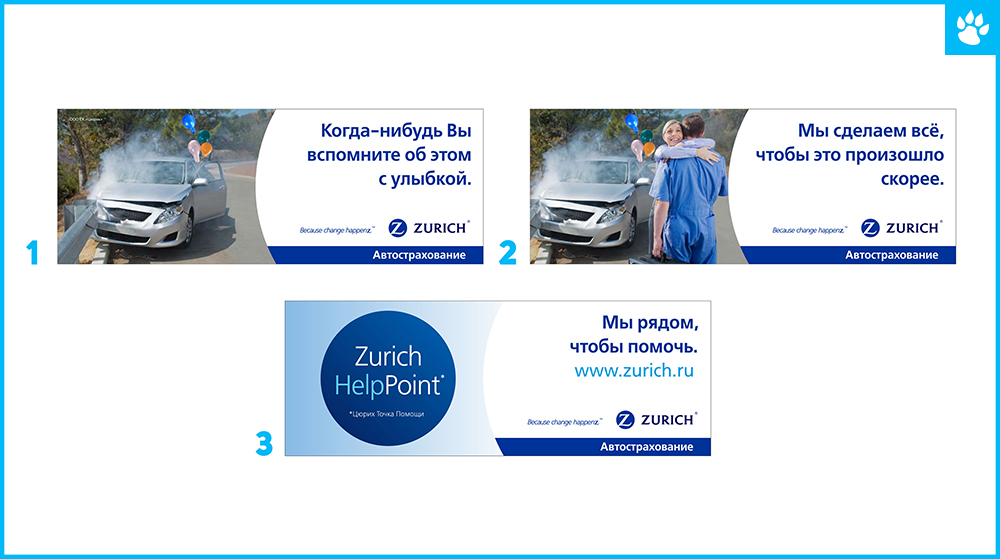
There is such a thing as a "wear" banner. Statistics show that the user is most likely to click on an ad when he sees it for the first or second time. In subsequent visits to the site, a person simply ceases to pay attention to the banner that has become familiar. Therefore, it is better to choose dynamic placement, in which several advertising messages are in constant rotation. Guests of the resource at each visit or after updating the page see a different advertisement, so the eye "does not blur."
2. Video advertising
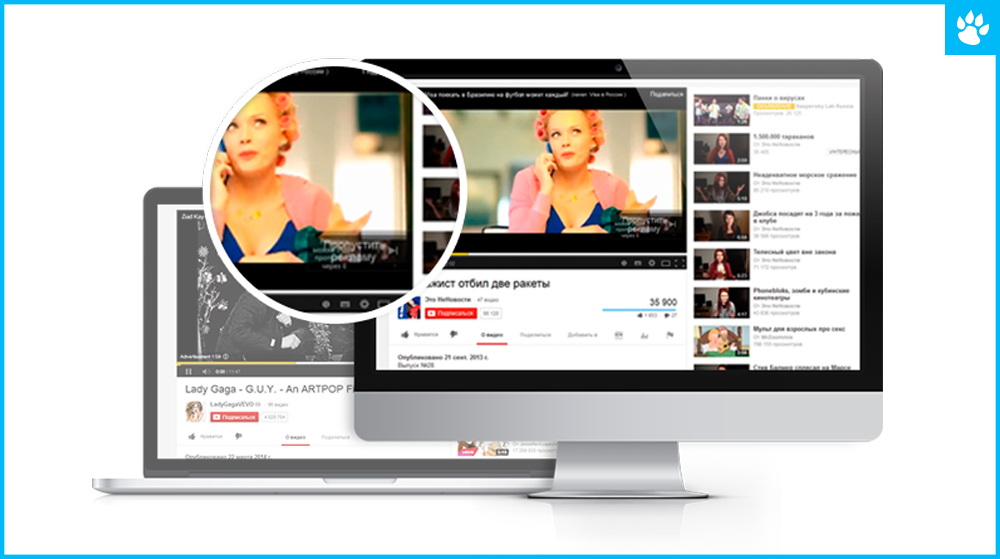
Video advertising appeared on the global network much later than classic graphic banners. Nevertheless, the high popularity of video content among users allowed it to become a more effective method of promotion. In video players on YouTube, Vimeo, and other video hosting sites, ads generally start at the start of playback, but there are other options.
- Pre-roll is an advertising video, the reproduction of which precedes a person’s viewing of the desired content. Unlike TV commercials, pre-roll usually lasts a maximum of 10-20 seconds. Using longer videos is irrational, because popular videos most often last no more than 5-7 minutes. The user can turn off the display of the advertising media clip after 5 or 10 seconds, but statistics show that over 40% of people watch the video to the end, even if they can skip it.
- Mid and post rolls are shown to users in the middle or end of the video being watched, respectively. If the video is long (film, recording a concert or a television show), advertising may be shown more often: for example, 4 times for the entire time or after the video is paused.
- Overlay doesn't look like the video ad formats not listed above. An overlay is a static banner located at the bottom of the player window. It is demonstrated directly while watching a video.
3. Branding
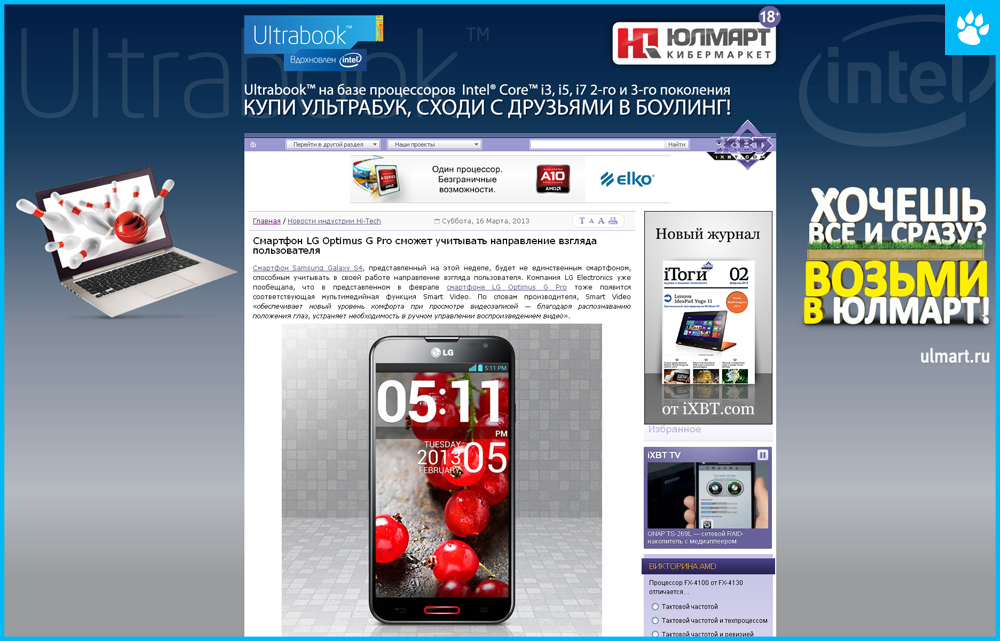
When listing types of display advertising, branding is worth mentioning. This is the most expensive kind of media advertising. Only large companies with an impressive advertising budget allow themselves to invest in branding a resource. The main purpose of branding is to popularize the brand, promote it, as well as inform users about important events - promotions, movie premieres, new products, etc.
A branded site always attracts the attention of an audience and helps to strengthen people's minds about the “exclusivity” of a product, event or brand. Therefore, branding makes sense only on popular resources.
Branded advertising is most often placed taking into account geographic targeting for a given period (day, week, month). Dates are tied to a specific event. Payment is calculated based on the total delivery time.
The high efficiency of branding as a promotion method is explained by the use of branded elements of the brand that are familiar to the audience in the site design. When branding, such techniques as coloring the search bar, creating a new advertising tab, replacing the usual cursor with an interactive advertising object are often used. But the biggest thing is the creation of a unique resource substrate, as in this example:

Original and creative branding interests the audience and does not cause a negative reaction among site visitors. But to make a brand-based advertising campaign truly powerful and effective, you need to bring real professionals to the business.
4. Text and graphic blocks
Text and graphic blocks are advertising elements that do not visually stand out from the overall site design. They do not look like traditional advertising - bright and colorful, but to informational messages of the resource (for example, to the recommendations of site experts). Therefore, in comparison with traditional banners, text-graphic blocks cause Internet users more confidence.
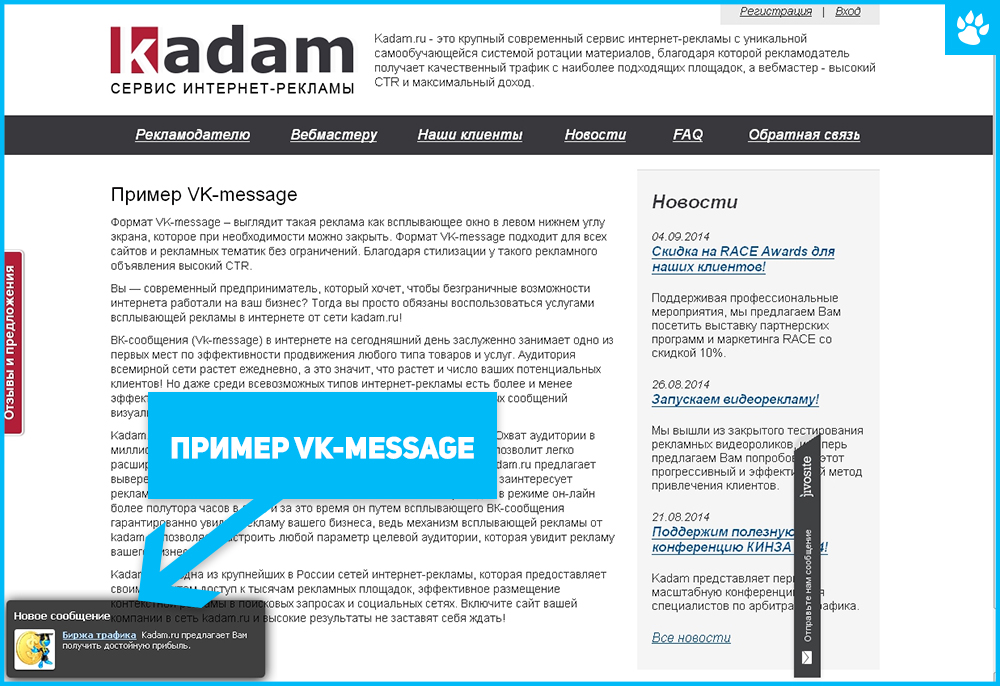
They are easy to manufacture: when creating an ad, you just need to accurately imitate the design of a particular site. The highest efficiency in terms of attracting an audience to an advertising message is shown by text-graphic blocks placed on thematic resources and containing CTA-elements.
Display targeting
Thematic targeting of banners and other elements of display advertising allows you to purposefully expose them to potential customers - people who are interested in services or products similar to those advertised. Targeting allows, for example, to show ads only to a male or only female audience interested in specific requests.
Geographic targeting is a tool that allows you to display advertising messages to people from specified cities or regions. This is beneficial for firms operating only in a particular city or area.
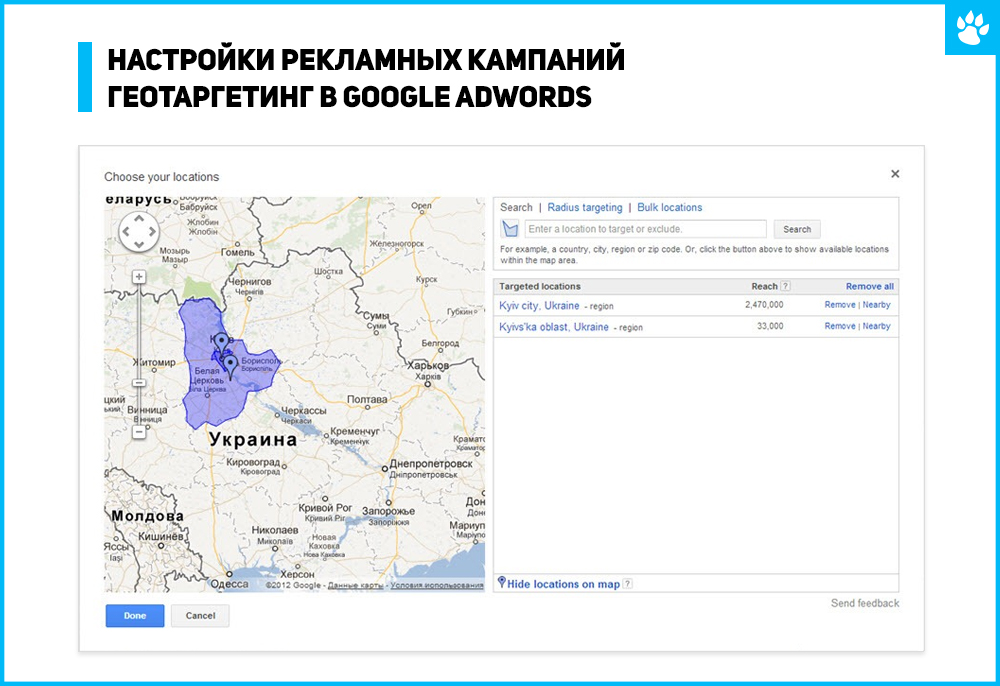
Geographically, a large-scale advertising campaign can be divided. Then users from different cities will see different banners or videos individually designed for each region, taking into account specific features.
Targeting allows you to choose the days of the week and even the exact time interval for displaying ads. According to statistics, almost 2/3 of users surf the Internet at the workplace. Therefore, displaying banners from 9 a.m. to 6 p.m. on business days is very effective. Not least for the reason that traditional advertising (on the radio, on television, in the media) is not accessible to users during this time period.
The advantages and disadvantages of display advertising
1. Pros
The main advantage of online media advertising in comparison with classic forms is accurate targeting. Your advertising can be shown exclusively on thematic platforms, it is possible to set the exact limits of the geographical location of users, time of display and other parameters.
Display ads can only be shown to the target audience. For example, Yandex displays banners that are similar in theme to the result of search results. And with the help of retargeting a potential customer, you can "return" to the page he viewed earlier.
Another advantage of display advertising is its flexibility and interactivity. Unlike advertising on radio or television, the user can interact with it: skip the advertising video, close the pop-up window or, conversely, go directly to the advertiser's website if the advertisement interests him.
- Communication with a potential client is built on the level of emotions.
- The ability to significantly increase resource traffic and / or sales in the shortest possible time.
- Availability of detailed statistics of impressions and transitions, which allows analyzing and timely adjusting the strategy.
- When posted on popular web resources, an advertising message will be seen by a wide range of users.
- This tool allows you to accelerate the popularization of a product or service and increase brand awareness.
2. Cons
Seamlessly move on to the shortcomings.
- If you don’t use targeting, click through rates of advertising messages will be very low.
- High costs for displaying media ads on popular resources.
- The user will not see the advertisement if the browser blocks its display.
- Creating a truly effective banner or video is an expensive pleasure.
- Due to the abuse of media advertising by some resources, she has formed a negative image.
- "Banner blindness." More about it below.
Banner blindness
Banner blindness of Internet users is perhaps the main drawback of display advertising. Let's find out what this phenomenon is and whether there are effective methods to combat it.
1. What is it?
Banner blindness is the conscious or unconscious ignoring by a visitor of a web resource of blocks containing advertising information. This concept was first used in 1998. Today, every specialist working in the field of Internet marketing is familiar with him.
Numerous studies show that people looking for certain information on the site do not even pay attention to large and bright banners. They ignore teasers that contain useful information.

Illustrative in this regard is an experiment conducted several years ago in the United States. On the official website of the United States Census Bureau, visitors were asked to find data on the current population of the country. The answer was in the upper right corner of the main page of the resource and was highlighted in red. Amazingly, 86% of the test participants did not complete the task. The main reason is that the block with the necessary information was located in the place where advertisements are usually placed.
Internet users “with experience” notice much less advertising in comparison with inexperienced users. Banner blindness is developing gradually due to increased advertising pressure on users. In fact, we ourselves reduce the effectiveness of teasers by overloading pages with display advertising.
Over time, each person has an idea about the appearance of typical teasers and their location on web pages. Many users know that clicking on an ad often does not do any good, and sometimes it can even be dangerous, redirecting the user to a fraudulent or virus-filled site.
The user's brain automatically ignores even the huge banners that are in the "header" of the page. Experts found that most often people, opening a page, glance at the top lines of the text, then go down and look at the text again horizontally. Then the user simply glances down. This "familiarization algorithm" with the contents of the page resembles the English letter F.
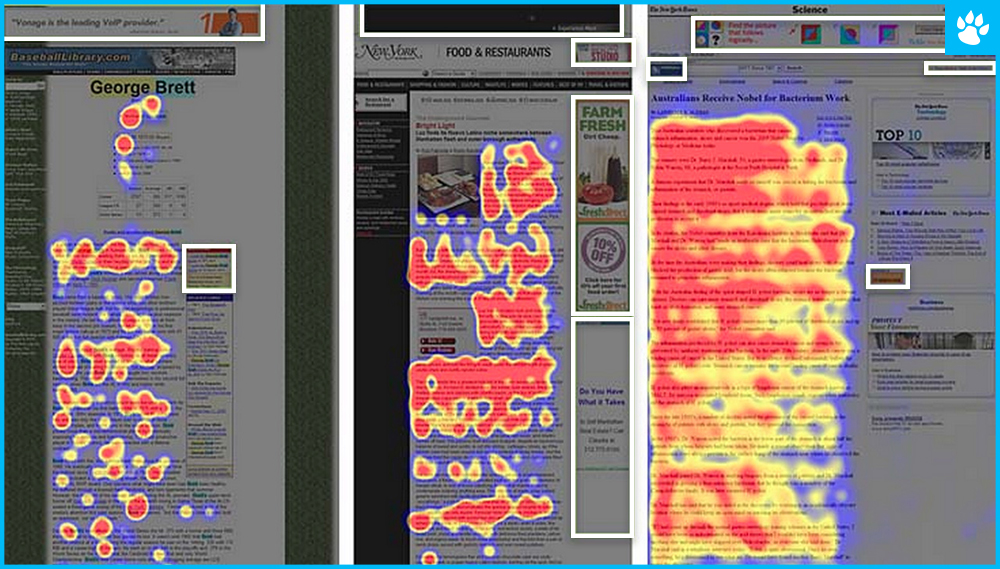
The left part of the web page is carefully viewed by 59% of visitors, the right - only 30%. And only one out of five users falls below the scroll line of the page. All these data are important to consider when choosing an ad placement.
2. How to deal with banner blindness?
So that banner blindness does not prevent the target audience from seeing your display advertising, you need to responsibly approach the issue of its placement. Installation of resource popanders and other elements that cause a negative reaction of users is undesirable. The easiest way is to change the location of the teasers. Create a heat map of the site, identify the “hottest” zones of web pages. By placing ads in them, you will increase its clickability.
Recently, on many resources banners are placed in the middle of text blocks. While users are not accustomed to this location of advertising, its click-through rate is relatively high.
The success of display advertising also depends on the professionalism of designers. Surprisingly, on some large resources, advertising shows high clickthrough rates only because it does not look like advertising. Such banners are more reminiscent of the information blocks of the sites themselves.
Creativity will help defeat banner blindness. Experiment with color scheme, appearance and text content of banners. Some resources use not entirely honest ways to increase clickability, for example, making out teasers in the form of operating system messages. Another dishonest technique is masking ads for page navigation elements. Audience reaction may be negative, but such banners will certainly be noticeable.
Test the design of advertising messages, change their placements, track user reactions and draw conclusions based on the data received. Defeating banner blindness by making banners effective is possible only by trial and error. A universal recipe for success does not exist here.
Media Ad Performance
Display advertising perfectly copes with its direct tasks - informing the audience about promotions and discounts, image promotion, and a rapid increase in website traffic. Media advertising allows you to track user behavior, analyze their reaction and change the advertising campaign strategy at any time.
Which type of banner advertising to choose depends on the budget of your advertising campaign and the goals set for it. Remember: in the conditions of fierce competition and the glut of the Internet with visual and textual information, when the user “gets his eyes shut”, the creativity and originality of your advertising is crucial. Be vibrant, experiment and surprise. If your message will stand out sharply from the monotonous flow of advertising information, potential customers will definitely notice it!
Check Callbackhunter on your own!
- Indicate with the promotional code: BLOG and get 15 free leads for the test.
- Tell me
